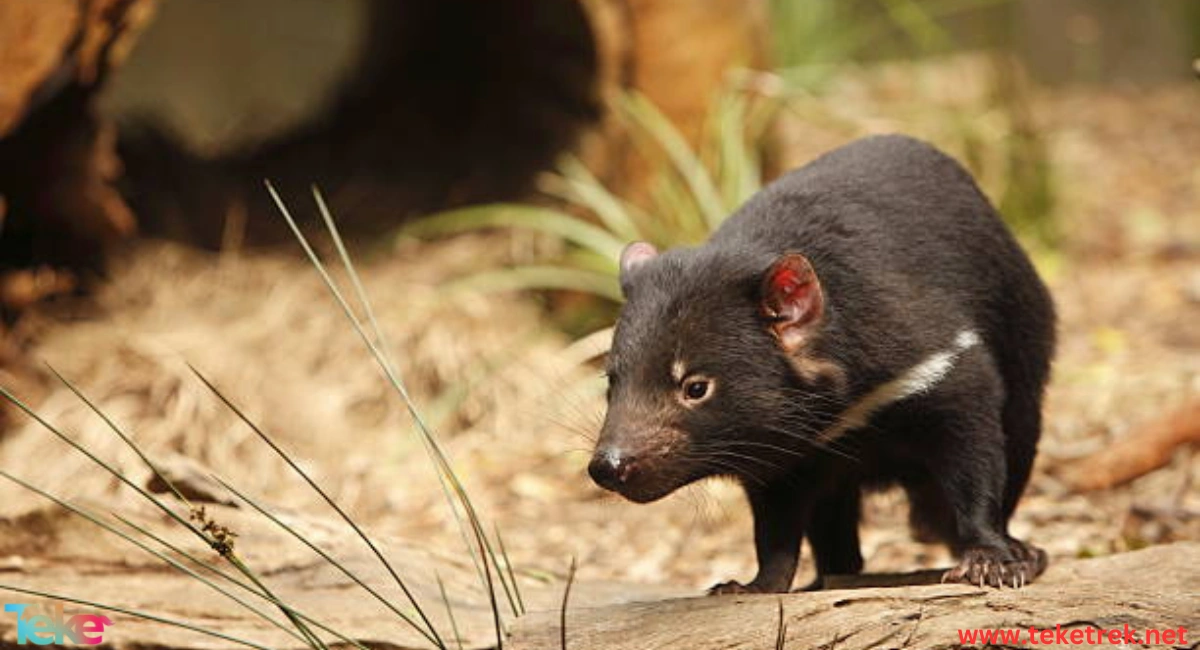Discover fascinating facts about the Tasmanian Devil, the fiercest and smallest of carnivores, which inhabits the Australian island of Tasmania. This unique creature is known for its ferocity and powerful jaws, which allow it to easily tear apart its prey, making it one of the most intriguing animals in the animal kingdom. Despite its small size, its ferocity and hunting abilities make it a symbol of survival and adaptation in its harsh environment.
Let’s learn more about it from teketrek.
Information about the Tasmanian Devil
Learn about the Tasmanian Devil, one of the most notable carnivorous marsupials in the world. Scientifically known as *Sarcophilus harrisii*, the Tasmanian Devil is exclusively found on the Australian island of Tasmania. This animal is characterized by its coarse fur, which ranges in color from dark brown to black, giving it the appearance of a small bear. Often, a white stripe or light patches can be seen on its chest.
The Tasmanian Devil has longer front legs compared to its hind legs, giving it a heavy, pig-like gait. It can grow up to 30 inches in length and weigh around 26 pounds. Its diet primarily consists of small animals such as frogs, birds, fish, and insects. Known for its ferocity and loud vocalizations while feeding, the Tasmanian Devil’s aggressive nature highlights its survival instincts in a harsh environment.

The primary habitat of the Tasmanian Devil
The primary habitat of the Tasmanian Devil once covered all of Australia, but it is now found only on the island of Tasmania. Its range extends across the entire island, where it inhabits coastal forests and dense woodlands. Scientists believe Tasmanian devils on the Australian mainland became extinct 400 years ago, possibly due to the introduction of Asian dingoes. These animals prefer to live alone in hollow tree trunks, caves, or burrows, and they emerge at night to search for food. Tasmanian Devils use their long whiskers, keen sense of smell, and sharp eyesight to avoid predators and locate prey and carrion. Known for their ferocity and large appetite, they consume almost everything, including hair and bones.
What is the reason behind the name “Tasmanian Devil”?
The name “Tasmanian Devil” is attributed to its aggressive behaviors, which terrified the early European settlers in Australia. When faced with a predator, fighting for a mate, or defending its food, the Tasmanian Devil enters a state of intense rage, characterized by teeth grinding and emitting terrifying sounds. These behaviors led the settlers to describe it as a “devil.” However, scientists believe that these aggressive actions may be ritualistic responses stemming from fear rather than evidence of its true nature. Despite its fearsome appearance, many of the Tasmanian Devil’s behaviors are aimed at self-defense and protecting its environment.
Reproduction in the Tasmanian Devil
The reproduction process of the Tasmanian Devil begins with a short gestation period of about three weeks, during which the female gives birth to 20 to 30 tiny, raisin-sized young. The hairless newborns crawl into the mother’s pouch to attach to one of the four teats inside. Due to the limited number of teats, only a few of the young survive. The babies remain in the pouch for four months before emerging and are fully weaned by the sixth month. This strategy ensures that the strongest of the young survive in a highly challenging environment.
Is the Tasmanian Devil an Extinct Animal?
No, the Tasmanian Devil is not an extinct animal, but it is considered endangered. In the late 19th century, efforts to eradicate Tasmanian Devils, which were deemed pests harmful to livestock, nearly wiped them out. However, in 1941, the government declared the species protected, leading to a gradual increase in their numbers. Unfortunately, in the mid-1990s, a catastrophic disease known as Devil Facial Tumor Disease (DFTD) was discovered, which has killed tens of thousands of them.
This disease causes large tumors to form around the mouth and head, hindering the ability to eat and ultimately leading to death by starvation. As a result, the Tasmanian Devil population has plummeted from 140,000 to as few as 20,000, prompting the International Union for Conservation of Nature (IUCN) to classify them as an endangered species.

Frequently Asked Questions (FAQs)
What does the Tasmanian Devil look like?
The Tasmanian Devil is characterized by its coarse brown or black fur and a stocky build, giving it the appearance of a small bear.
What does the Tasmanian Devil sound like?
The Tasmanian Devil produces a loud and raucous noise, often described as a scream or a disturbing roar, which can be both terrifying and unsettling.
In conclusion, the Tasmanian Devil is one of the most fascinating animals due to its unique appearance and peculiar behaviors. Despite the survival challenges it faces, ongoing conservation efforts offer hope for the continued existence of this remarkable species. However, studying and protecting the Tasmanian Devil remains an environmental duty to ensure the diversity and sustainability of wildlife.
Refrences





